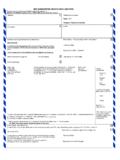Transcription of SAFETY DATA SHEET ULTIMEG 2000/380 - …
1 REVISION DATE: 26/07/2010 SAFETY data SHEETULTIMEG 2000 /3801 IDENTIFICATION OF THE SUBSTANCE/PREPARATION AND OF THE COMPANY/UNDERTAKINGPRODUCT NAMEULTIMEG 2000 /380 AEV LIMITEDSUPPLIERMARION STREETBIRKENHEADMERSEYSIDECH41 6 LTTel. +44(0)151 647 3322 Fax. +44(0)151 647 3377 PRODUCT HAZARDS IDENTIFICATIONF lammable. Irritating to respiratory system. Toxic to aquatic organisms, may cause long-term adverse effects in the aquatic environment. Repeated exposure may cause skin dryness or (1999/45)Xi;R37. N;R51/53. R10, COMPOSITION/INFORMATION ON INGREDIENTSEC (67/548) SOLVENTXn;R65. Xi;R37. N;R51/53. SPIRITXn;R65. N;R51/53. R10, Full Text for all R-Phrases are Displayed in Section 164 FIRST-AID MEASURESGENERAL INFORMATIONMove the exposed person to fresh air at once. Get medical attention if any discomfort the exposed person to fresh air at once.
2 Keep the affected person warm and at rest. Get prompt medical NOT INDUCE VOMITING! Immediately rinse mouth and provide fresh air. Get medical attention immediately!SKIN CONTACTR emove affected person from source of contamination. Remove contaminated clothing. Wash the skin immediately with soap and water. Get medical attention if any discomfort CONTACTI mmediately flush with plenty of water for up to 15 minutes. Remove any contact lenses and open eyes wide apart. Get medical attention if any discomfort FIRE-FIGHTING MEASURESEXTINGUISHING MEDIAFire can be extinguished using: Foam. Dry chemicals, sand, dolomite FIRE FIGHTING PROCEDURESA void breathing fire vapours. Cool containers exposed to flames with water until well after the fire is out. Keep run-off water out of sewers and water sources. Dike for water FIRE & EXPLOSION HAZARDSFire creates: Toxic gases/vapours/fumes of Carbon.
3 Carbon dioxide (CO2). Carbon monoxide (CO). Hydrocarbons. Nitrous gases (NOx).6 ACCIDENTAL RELEASE MEASURESSPILL CLEAN UP METHODSE xtinguish all ignition sources. Avoid sparks, flames, heat and smoking. Ventilate. Clean-up personnel should use respiratory and/or liquid contact protection. Absorb in vermiculite, dry sand or earth and place into HANDLING AND STORAGE41/REVISION DATE: 26/07/2010 ULTIMEG 2000 /380 USAGE PRECAUTIONSD uring application and drying, solvent vapours will be emitted. Avoid inhalation of vapours. Do not use in confined spaces without adequate ventilation and/or respirator. Ventilate well, avoid breathing vapours. Use approved respirator if air contamination is above accepted level. Mechanical ventilation or local exhaust ventilation is required. Use explosion proof electric equipment. Keep away from heat, sparks and open PRECAUTIONSF lammable/combustible - Keep away from oxidisers, heat and flames.
4 Store in tightly closed original container in a dry and cool place. Keep in original CLASSF lammable liquid EXPOSURE CONTROLS/PERSONAL PROTECTIONStdSTEL - 15 minTWA - 8 hrsNameNotes50 ppmWELHYDROCARBON SOLVENT600 mg/m3 WELWHITE SPIRITWEL = Workplace Exposure COMMENTSWEL = Workplace Exposure LimitsPROTECTIVE EQUIPMENTPROCESS CONDITIONSUse engineering controls to reduce air contamination to permissible exposure MEASURESWell-ventilated EQUIPMENTR espiratory protection must be used if air contamination exceeds acceptable level. Chemical respirator with organic vapour PROTECTIONUse protective gloves. Nitrile gloves are recommended, but be aware that the liquid may penetrate the gloves. Frequent change is PROTECTIONUse approved SAFETY goggles or face PROTECTIONWear appropriate clothing to prevent any possibility of liquid contact and repeated or prolonged vapour MEASURESDO NOT SMOKE IN WORK AREA!
5 Wash at the end of each work shift and before eating, smoking and using the toilet. Wash promptly with soap & water if skin becomes contaminated. Promptly remove any clothing that becomes contaminated. Use appropriate skin cream to prevent drying of skin. When using do not eat, drink or PHYSICAL AND CHEMICAL PROPERTIESAPPEARANCEL iquidCOLOURS trawODOURO rganic data COMMENTSI nformation given concerns the major in waterBOILING POINT ( C)150 - - 203 760 mm HgRELATIVE 23 VAPOUR DENSITY (air=1) mPa 23 VISCOSITY3 Ps 25 FLASH POINT ( C)38 CC (Closed cup).AUTO IGNITIONTEMPERATURE ( C)230 FLAMMABILITY LIMIT - LOWER(%) LIMIT - UPPER(%) DATE: 26/07/2010 ULTIMEG 2000 /38010 STABILITY AND REACTIVITYSTABILITYS table under normal temperature TO AVOIDA void heat. Avoid contact with oxidisers or reducing DECOMPOSITION PRODUCTSFire creates: Toxic gases/vapours/fumes of: Carbon monoxide (CO).
6 Carbon dioxide (CO2).11 TOXICOLOGICAL INFORMATIONINHALATIONMay cause irritation to the respiratory system. Vapours may cause headache, fatigue, dizziness and if swallowed. May cause internal CONTACTP roduct has a defatting effect on skin. Liquid may irritate CONTACTI rritation of eyes and mucous WARNINGSINHALATION. May cause irritation to the respiratory system. SKIN CONTACT. Irritating to skin. Acts as a defatting agent on skin. May cause cracking of skin, and eczema. EYE CONTACT. Irritating to eyes. INGESTION. May cause stomach pain or OF ENTRYI nhalation. Skin ECOLOGICAL INFORMATIONECOTOXICITYD angerous for the environment: May cause long-term adverse effects in the aquatic DISPOSAL CONSIDERATIONSDISPOSAL METHODSD ispose of waste and residues in accordance with local authority TRANSPORT INFORMATIONPROPER SHIPPING NAMEPAINT1263UN NO.
7 ROAD3 ADR CLASS 3: Flammable CLASS3 ADR LABEL NO. SEA3 IMDG CLASSIIIIMDG PACK , S-EEMSMARINE POLLUTANT1263UN NO. AIR3 AIR CLASSIIIAIR PACK REGULATORY INFORMATIONLABELLING43/REVISION DATE: 26/07/2010 ULTIMEG 2000 /380 IrritantDangerous for the environmentRISK to respiratory to aquatic organisms, may cause long-term adverse effects in the aquatic exposure may cause skin dryness or PHRASESS37 Wear suitable only in well-ventilated appropriate containment to avoid environmental material and its container must be disposed of as hazardous release to the environment. Refer to special instructions/ SAFETY data REGULATORY REFERENCESP etroleum (Consolidation) Act, as amended 1984 SI 1244. Highly Flammable Liquid Regulations LISTINGR ivers (Prevention of Pollution) Act 1961. Control of Pollution (Special Waste Regulations) Act DIRECTIVESS ystem of specific information relating to Dangerous Preparations.
8 2001/58/EC. Regulation (EC) No 1907/2006 of the European Parliament and of the Council of 18 December 2006 concerning the Registration, Evaluation, Authorisation and Restriction of Chemicals (REACH), establishing a European Chemicals Agency, amending Directive 1999/45/EC and repealing Council Regulation (EEC) No 793/93 and Commission Regulation (EC) No 1488/94 as well as Council Directive 76/769/EEC and Commission Directives 91/155/EEC, 93/67/EEC, 93/105/EC and 2000 /21/EC, including INSTRUMENTSC hemicals (Hazard Information and Packaging) Regulations. Control of Substances Hazardous to CODE OF PRACTICEC lassification and Labelling of Substances and Preparations Dangerous for NOTESW orkplace Exposure Limits EH40. Introduction to Local Exhaust Ventilation HS(G)37. CHIP for everyone HSG(108).16 OTHER INFORMATIONREVISION DATE26/07/2010 REV.
9 SDS GENERATED10 SDS PHRASES IN : may cause lung damage if to respiratory exposure may cause skin dryness or to aquatic organisms, may cause long-term adverse effects in the aquatic







